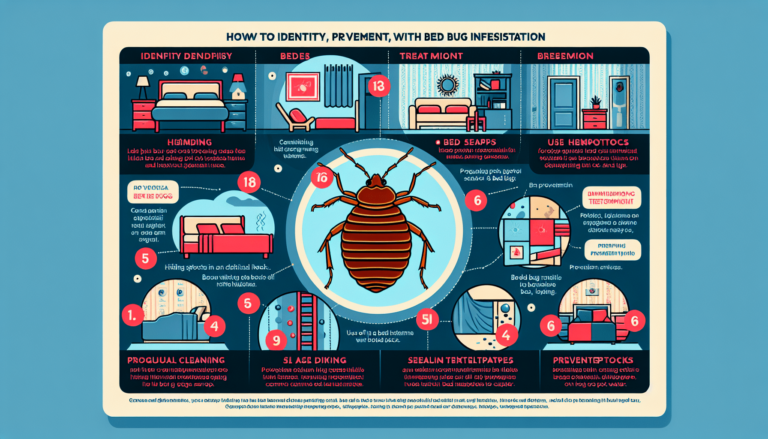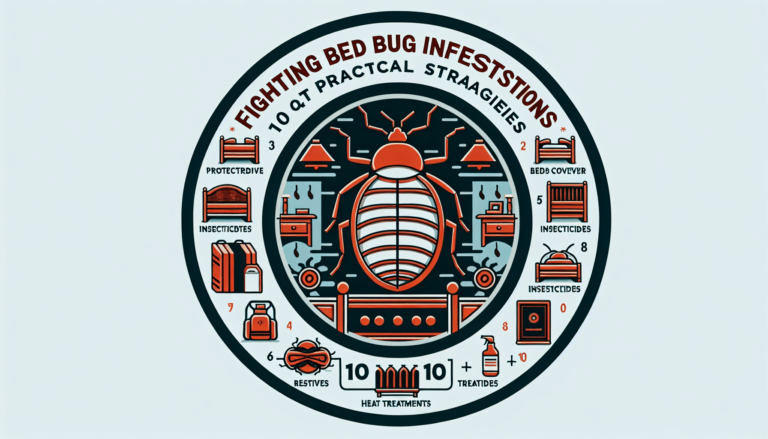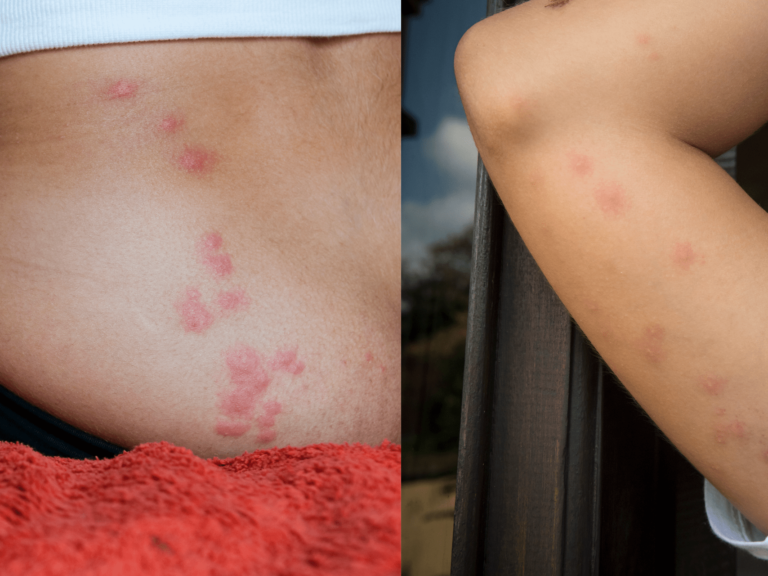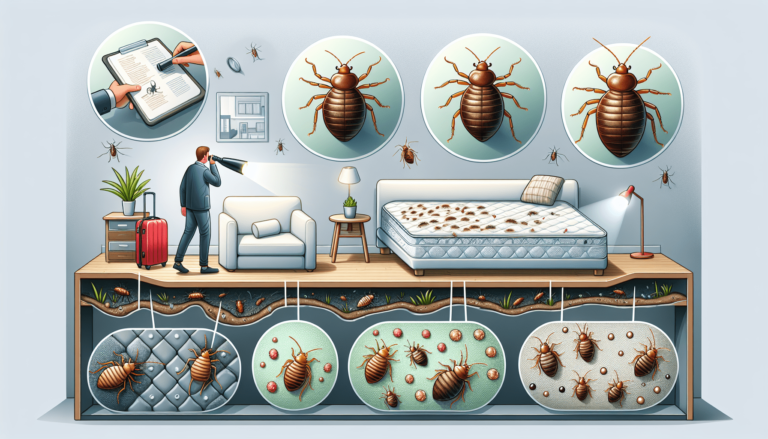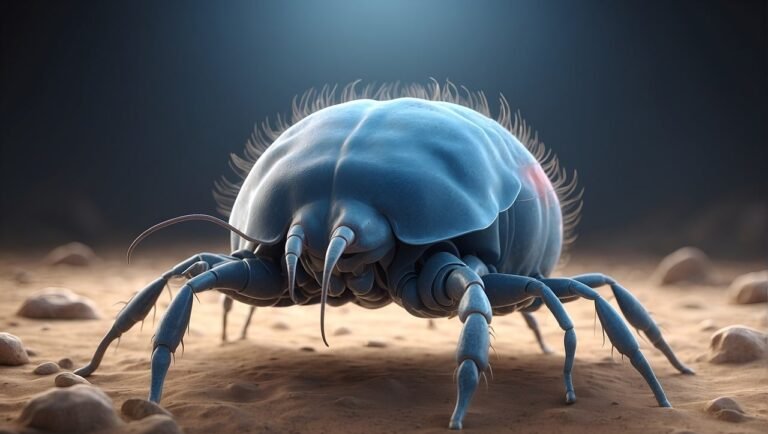5 Essential Steps to Take if You Encounter Bed Bugs
If you find yourself facing the distressing situation of encountering bed bugs, it is crucial to know the essential steps to take in order to effectively handle the problem. This article serves as a comprehensive guide to equip you with the knowledge and strategies necessary to tackle the issue head-on. From practical tips on containment and removal to expert advice on preventing future infestations, this resource aims to empower you with the information needed to navigate this challenging situation with confidence. By following these five essential steps, you will be well-prepared to address the presence of bed bugs and protect yourself from their impact.
Identifying Bed bug Infestation
Bed bugs can easily infest your home without you even realizing it. In order to effectively address the problem, it is important to first identify the presence of bed bugs. There are a few key ways to determine if you have a bed bug infestation.
Understanding physical appearance of bed bugs
Bed bugs are small, flat insects that are typically brown or reddish-brown in color. They have a distinct oval-shaped body and are about the size of an apple seed. Adult bed bugs have six legs and antennae. It is important to familiarize yourself with the physical appearance of bed bugs so that you can easily identify them.
Examining signs of bed bugs
Aside from actually seeing the bed bugs themselves, there are a few signs that can indicate their presence. Look for small, reddish-brown spots on your bedding or furniture. These spots are bed bug excrement and are often left behind as evidence. You may also notice small blood stains on your sheets or pillowcases as a result of bed bug feeding.
Another sign of a bed bug infestation is the presence of molted skins. Bed bugs shed their exoskeletons as they grow, so finding these discarded skins is a clear indication of their presence. Additionally, you may notice a sweet, musty odor in the area where bed bugs are present.
Checking common bed bug hiding spots
Bed bugs are excellent at hiding and can easily go unnoticed. They tend to hide in cracks and crevices, making it important to thoroughly inspect your home for any signs of infestation. Common hiding spots include mattress seams, behind headboards and picture frames, and in electrical outlets. Look for any signs of bed bugs in these areas, such as live bugs, droppings, or molted skins.
Indications of bed bug bites on your body
Bed bug bites can be another indication of an infestation. These bites often appear as small, red welts that are itchy and may be arranged in a line or cluster. However, it is important to note that not everyone reacts to bed bug bites, so the absence of bites does not necessarily mean that you do not have an infestation.
If you suspect that you have a bed bug infestation, it is important to take immediate action to prevent further spread and address the problem effectively.
Preventing Further Infestation
Once you have identified a bed bug infestation, it is crucial to prevent further spread and ensure that all existing bed bugs are eliminated. Taking the following steps can help contain the infestation and prevent it from worsening.
Containing the infestation
Start by isolating the infested area. This means removing all the bedding, linens, and clothing from the affected area and placing them in sealed plastic bags to prevent bed bugs from spreading to other parts of the house. It is also important to seal any cracks or crevices that bed bugs could use to travel between rooms.
Regular cleaning and vacuuming
Regularly cleaning and vacuuming your home can help remove any stray bed bugs or eggs. Pay close attention to areas where bed bugs are likely to hide, such as mattress seams, furniture joints, and baseboards. Remember to empty the vacuum cleaner immediately after use and dispose of the contents in a sealed bag.
Washing and drying clothes and bedding at high temperatures
Washing and drying your clothes and bedding at high temperatures can help kill any bed bugs or eggs that may be present. Use the hottest water and dryer settings possible to ensure that all bed bugs are eradicated. If you are unable to wash or dry certain items at high temperatures, consider using a dryer on high heat for at least 30 minutes.
Dispose of heavily infested items
In cases of severe infestation, it may be necessary to dispose of heavily infested items such as mattresses, furniture, or carpets. Wrap these items in plastic and clearly mark them as infested to prevent others from taking them. Be sure to check local regulations for proper disposal methods.
Sealing cracks and crevices
To prevent future infestations, it is important to seal any cracks or crevices in your home where bed bugs can hide. Use caulk or sealant to close up gaps around baseboards, electrical outlets, and pipes. Inspect and repair any torn wallpaper or peeling paint, as bed bugs can hide in these areas as well.
By taking these preventive measures, you can effectively contain the infestation and reduce the risk of further spreading bed bugs to other areas of your home.

This image is property of cdn.shopify.com.
Choosing an appropriate treatment method
Once you have taken steps to contain the infestation, it is time to choose an appropriate treatment method to eliminate the bed bugs. There are several options to consider, each with its own pros and cons.
Understanding pros and cons of various treatment methods
Some common treatment methods for bed bugs include Heat treatment, pesticide application, and freezing. Heat treatment involves exposing the infested area to high temperatures, which effectively kills bed bugs and their eggs. Pesticide application involves using insecticides to directly kill bed bugs and prevent future infestations.
Freezing is another option, which involves exposing infested items to subzero temperatures for a certain period of time. However, it is important to note that freezing is only effective if the temperature is maintained consistently throughout the treatment process.
Each treatment method has its own advantages and limitations, so it is important to carefully consider which option is best suited for your specific situation.
DIY solutions and their effectiveness
There are various do-it-yourself (DIY) solutions available for bed bug treatment, such as sprays, powders, and mattress encasements. While these products can be effective in some cases, they may not fully eliminate a bed bug infestation, especially if it is severe. DIY solutions also require thoroughness and multiple treatments to be effective.
Professional pest control services
Hiring a professional pest control service is often the most effective and efficient way to eliminate a bed bug infestation. Professional technicians have the knowledge, experience, and specialized equipment to thoroughly treat your home and ensure that all bed bugs are eradicated. They will also provide guidance on post-treatment prevention methods to prevent future infestations.
When choosing a professional pest control service, be sure to research and select a reputable company with good reviews and proper certifications in bed bug treatment.
Using heat treatment or pesticides
Heat treatment and pesticide application are two common methods used by professional pest control services. Heat treatment involves raising the temperature in the infested area to a level that is lethal to bed bugs and their eggs. This method is effective, chemical-free, and environmentally friendly. However, it requires specialized equipment and may be more expensive than other treatment options.
Pesticide application involves using insecticides to directly kill bed bugs and prevent future infestations. While effective, it is important to follow all safety precautions and guidelines provided by the pest control professional to ensure the proper usage of pesticides.
Ultimately, the choice between heat treatment and pesticide application depends on factors such as the severity of the infestation, your budget, and personal preferences.
Implementing chosen treatment
Once you have chosen a treatment method, it is important to follow the appropriate steps and guidelines for its implementation. This will ensure that the treatment is effective and that all bed bugs are eradicated.
Safety measures during treatment
Before implementing any treatment method, it is important to prioritize safety. Make sure to read and follow all instructions provided by the product manufacturer or pest control professional. Use personal protective equipment, such as gloves and masks, when handling chemicals or using heat treatment equipment. Keep children and pets away from treated areas until it is safe to re-enter.
Proper usage of bed bug pesticides
If you choose to use bed bug pesticides, it is important to understand how to properly use them. Follow the instructions provided by the manufacturer or pest control professional regarding the application method, dosage, and frequency. Be aware of any potential risks or side effects associated with the pesticide and take necessary precautions.
Effective application of heat treatment
If you opt for heat treatment, it is important to properly apply the treatment to ensure effectiveness. Consult with a professional pest control technician to determine the appropriate temperature and duration for treatment. Make sure to evenly distribute heat throughout the infested area and monitor the temperature closely to ensure that it remains at the desired level for the required duration.
Utilizing professional services appropriately
If you decide to hire a professional pest control service, make sure to communicate openly and effectively with the technicians. Provide them with all necessary information about the infestation, including the areas affected and any previous treatment attempts. Follow their instructions regarding preparation for treatment, such as removing clutter or covering sensitive items. Cooperate with the technicians throughout the treatment process and follow their recommendations for post-treatment prevention.
By implementing the chosen treatment method correctly, you can effectively eliminate bed bugs and prevent future infestations.

This image is property of hicare.in.
Post-Treatment Steps
After completing the bed bug treatment, it is important to take post-treatment steps to ensure that the infestation does not reoccur.
Rechecking for signs of bed bugs
Even after treatment, it is crucial to remain vigilant and continue monitoring for any signs of bed bug activity. Inspect your home regularly, paying close attention to areas where bed bugs are likely to hide, such as cracks and crevices. If you notice any signs of infestation, contact a professional pest control service immediately to address the issue.
Ongoing prevention methods
Prevention is key to avoiding future bed bug infestations. Make sure to seal any cracks or crevices in your home, repair torn wallpaper or peeling paint, and regularly clean and vacuum your home to remove any stray bed bugs or eggs. Consider using mattress encasements or bed bug-proof covers to protect your bedding and furniture.
Maintaining cleanliness and hygiene
Good hygiene practices can help prevent bed bugs from infesting your home. Wash your bedding, linens, and clothing regularly at high temperatures to kill any bed bugs or eggs. Avoid bringing used furniture or clothing into your home without thoroughly inspecting it for signs of infestation.
Ongoing monitoring and vigilance
Stay vigilant and continue monitoring for any signs of bed bugs on an ongoing basis. If you notice any suspicious activity or bites on your body, take immediate action to prevent a potential infestation from worsening.
By following these post-treatment steps, you can reduce the risk of future bed bug infestations and maintain a bed bug-free environment.
Understanding bed bugs behavior
To effectively address bed bug infestations, it is important to understand their behavior and habits. This knowledge can help in identifying infestations early and implementing preventive measures.
Life cycle of bed bugs
Bed bugs go through a life cycle consisting of several stages: egg, nymph, and adult. Female bed bugs lay eggs, which hatch into nymphs. Nymphs resemble smaller versions of adult bed bugs, but are not yet sexually mature. They molt several times before reaching adulthood. Adult bed bugs can lay hundreds of eggs during their lifetime.
Feeding habits of bed bugs
Bed bugs are nocturnal insects that feed on blood. They are attracted to warmth and carbon dioxide, which is why they are often found in areas close to their hosts, such as beds or couches. Bed bugs typically feed every five to ten days and can survive for several months without feeding.
Reproduction and growth of bed bugs
Bed bugs reproduce quickly, with each female capable of laying multiple eggs daily. The eggs are usually laid in cracks and crevices, and can be difficult to detect. Once the eggs hatch, nymphs begin feeding and growing until they reach adulthood. The entire life cycle from egg to adult can take anywhere from several weeks to several months, depending on environmental conditions.
By understanding bed bugs’ behavior, you can better anticipate their presence and take proactive measures to prevent infestations.

This image is property of cdn.domyown.com.
Impact of bed bugs on health
Bed bugs not only cause physical discomfort, but they can also have negative impacts on your health and well-being. It is important to be aware of these effects in order to address and prevent bed bug infestations effectively.
Physical health implications
Although bed bugs are not known to transmit diseases, their bites can cause various physical health issues. Bed bug bites often result in red, itchy welts that can become inflamed and irritated. Scratching the bites can lead to secondary infections. In rare cases, some individuals may experience severe allergic reactions to bed bug bites.
Psychological effects of bed bug infestation
Bed bug infestations can also have psychological effects on individuals. The presence of bed bugs can cause stress, anxiety, and sleep disturbances. The constant fear of being bitten or having a bed bug infestation can significantly impact mental well-being and quality of life.
Long term health effects
While the immediate physical and psychological effects of bed bugs are troublesome, there can also be long-term health effects. Chronic sleep deprivation due to bed bug infestations can lead to a weakened immune system, increased susceptibility to illnesses, and cognitive impairments. Additionally, the stress and anxiety caused by infestations can have long-lasting impacts on mental health.
By addressing bed bug infestations promptly and effectively, you can protect both your physical and mental well-being.
Myths and misconceptions about bed bugs
There are many myths and misconceptions surrounding bed bugs, which can often lead to confusion and ineffective treatment methods. It is important to debunk these myths and understand the facts about bed bugs in order to effectively address infestations.
Debunking common myths
One common myth about bed bugs is that they only infest dirty or unsanitary environments. In reality, bed bugs can infest even the cleanest of homes as they are primarily attracted to warmth and carbon dioxide. Another myth is that bed bugs are only found in beds. While they are often found in mattresses and box springs, they can also hide in other areas such as furniture, baseboards, and electrical outlets.
Reality versus rumors about bed bugs
Contrary to popular belief, bed bugs are not a result of poor hygiene or cleanliness. They can infest any location, from residential homes to hotels and public transportation. Bed bugs are excellent hitchhikers and can easily latch onto clothing, luggage, or other personal belongings to spread to new locations.
Understanding facts about bed bugs
Understanding the facts about bed bugs is crucial in effectively addressing and preventing infestations. Bed bugs are resilient pests that require thorough treatment and ongoing monitoring. They can reproduce quickly and can be challenging to completely eliminate without professional help. Early detection, prompt action, and proper treatment are key to successfully dealing with bed bug infestations.
By separating fact from fiction, you can approach bed bug infestations with the necessary knowledge and take appropriate actions to eliminate them.

This image is property of smithspestmanagement.com.
Legal implications of bed bugs infestation
Bed bug infestations can lead to legal issues, particularly in cases involving tenants and landlords. It is important to understand the legal implications surrounding bed bugs in order to protect your rights and seek appropriate solutions.
Tenants rights in case of bed bugs
Tenants have the right to a safe and habitable living environment, free from bed bug infestations. If a tenant discovers bed bugs in their rental unit, they should promptly notify their landlord or property management. The landlord is generally responsible for addressing the infestation and providing necessary pest control treatments.
If the landlord fails to take action, tenants may be entitled to legal remedies such as rent withholding, lease termination, or reimbursement for expenses related to bed bug treatment. Each jurisdiction may have different laws and regulations regarding tenants’ rights, so it is important to consult local laws or seek legal advice when dealing with bed bug infestations as a tenant.
Landlord’s responsibility in managing bed bugs
Landlords are typically responsible for maintaining a safe and habitable living environment for their tenants. This includes addressing any bed bug infestations that may occur. When notified of a bed bug infestation, landlords should take immediate action to arrange for professional pest control treatment.
It is important for landlords to understand their legal obligations and fulfill them promptly. Failure to address a bed bug infestation can not only lead to legal consequences but also damage the reputation of the property and impact the well-being of tenants.
Legal solutions for a bed bug problem
In some cases, disputes regarding bed bug infestations may escalate to legal action. Seeking legal advice or mediation can be helpful in finding a resolution. It may be necessary to gather evidence such as photographs, documentation of communication with the landlord, and receipts for expenses related to bed bug treatment.
While legal action should always be a last resort, understanding the legal implications of bed bug infestations can help tenants and landlords navigate potential disputes more effectively.
Bed bugs in different settings
Bed bugs are not limited to residential premises and can be found in various settings. It is important to understand how to manage and prevent bed bugs in different environments to minimize the risk of infestation.
Bed bugs in residential premises
Bed bugs can easily infest residential premises, including houses, apartments, and condominiums. The close proximity of living spaces and shared walls can allow bed bugs to travel easily between units. It is important for residents to take preventive measures such as regular cleaning, vacuuming, and sealing cracks and crevices to prevent infestations.
Managing bed bugs in public places like hotels and hostels
Hotels, hostels, and other public accommodations are prone to bed bug infestations due to the high turnover of guests and frequent travel. These establishments should have proper protocols in place to monitor for bed bugs, respond to guest reports promptly, and implement effective treatment methods. Regular inspections, training for staff, and proper maintenance can help prevent infestations and protect guests.
Preventing bed bugs in commercial buildings
Commercial buildings, such as offices, retail stores, and healthcare facilities, are not immune to bed bug infestations. Bed bugs can hitchhike on clothing, bags, or furniture brought into the building. Regular cleaning, inspections, and employee education on bed bug prevention can help minimize the risk of infestations in commercial settings.
By understanding the unique challenges and preventive measures associated with different settings, you can effectively manage and prevent bed bug infestations.

This image is property of hips.hearstapps.com.
Conclusion
Encountering a bed bug infestation can be a stressful and challenging experience, but by following the steps outlined in this article, you can effectively address and prevent bed bug infestations. Start by identifying the presence of bed bugs through physical appearance and examining signs of infestation. Take preventive measures to contain the infestation and prevent further spread. Choose an appropriate treatment method based on the pros and cons of various options, considering DIY solutions, professional pest control services, and the use of heat treatment or pesticides. Implement the chosen treatment method with safety measures and proper usage of products or equipment. After treatment, take post-treatment steps to prevent reinfestation and understand the behavior of bed bugs to better address infestations. Recognize the impact of bed bugs on health and dispel myths and misconceptions surrounding them. Be aware of the legal implications of bed bug infestations, considering tenants’ rights and landlords’ responsibilities. Finally, understand how bed bugs can infest different settings and take preventive measures accordingly.
By staying knowledgeable and proactive, you can effectively manage and prevent bed bug infestations, ensuring a safe and comfortable environment for you and your family.

